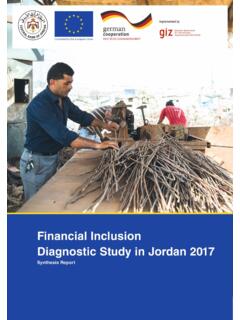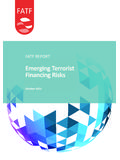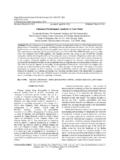Transcription of An Analysis of Personal Financial Literacy Among …
1 Financial SERVICES REVIEW, 7(2): 107-128 Copyright 1998 by JAI Press Inc. ISSN: 1057-0810 All rights of reproduction in any form reserved. An Analysis of Personal Financial Literacy Among College Students Haiyang Chen and Ronald P. Volpe This study surveys 924 college students to examine their Personal Financial Literacy ; the relationship between the Literacy and students' characteristics; and impact of the liter- acy on students' opinions and decisions. Results show that participants answer about 53% of questions correctly. Non-business majors, women, students in the lower class ranks, under age 30, and with little work experience have lower levels of knowledge. Less knowledgeable students tend to hoM wrong opinions and make incorrect deci- sions.
2 It is concluded that college students are not knowledgeable about Personal finance. The low level of knowledge will limit their ability to make informed decisions. I. ~TRODUCTION The ability to manage Personal finances has become increasingly important in today's world. People must plan for long-term investments for their retirement and children's edu- cation. They must also decide on short-term savings and borrowing for a vacation, a down payment for a house, a car loan, and other big-ticket items. Additionally, they must manage their own medical and life insurance needs. Unfortunately, studies have shown that Americans have inadequate knowledge of per- sonal finances (EBRI, 1995; KPMG, 1995; PSRA, 1996, 1997; Oppenheimer Funds/Girls Inc.)
3 , 1997; Vanguard Group/Money Magazine, 1997). They fail to make correct decisions because they have not received a sound Personal finance education (HSR, 1993; Hira, 1993; O'Neill, 1993). This study has three purposes. First, it provides evidence of Personal finance Literacy Among college students. Second, it examines why some college students are relatively more knowledgeable than others. The Analysis may help us identify factors that determine the level of competency possessed by college students. The third purpose is to examine how a student's knowledge influences his/her opinions and decisions on Personal Financial issues. Haiyang Chen Professor of Finance, The Williamson College of Business Administration, Youngstown State University, Youngstown, Ohio 44555; Phone: (330) 742-1883; Fax: (330) 742- 1459; E-mail: Ronald P.
4 Volpe Professor of Finance, The Williamson College of Business Administration, Youngstown State University, Youngstown, Ohio 44555. 108 Financial SERVICES REVIEW 7(2) 1998 The paper is organized as follows. Section II reviews previous studies on Financial lit- eracy. Section III discusses methodology. Section IV presents results. Section V concludes the paper. II. LITERATURE REVIEW Most of the previous studies are conducted by practitioners in the Financial service indus- try. They focus on money management and investment-related issues. This emphasis is consistent with findings of the Certified Financial Planners, indicating these issues are important areas of Personal Financial planning (NEFE, 1993-1996). The results of these studies show that the participants generally answered fewer than 60% of survey questions correctly.
5 Prior studies of high school students consistently find that they are not receiving a good education in Personal Financial fundamentals and have poor knowledge (Bakken, 1967; CFAJAMEX, 1991; HSR, 1993; Langrehr, 1979; NAEP, 1979). In a recent study of 1,509 high school seniors from 63 schools, Mandell (1997) reports an average correct score of 57% in the areas of income, money management, savings and investment, and spending. His conclusion is that students are leaving schools without the ability to make critical deci- sions affecting their lives. Do adults have a good command of Personal finance and investments? Results of sev- eral studies suggest that they do not. Princeton Survey Research Associates (1997) surveys 1,770 households nationwide on their Financial knowledge and find an average correct score of 42%.
6 This result shows that household Financial decision makers do not have a good grasp of basic finance concepts. In another study of 522 adult women, 56% are found not very knowledgeable about investing (Oppenheimer Funds/Girls Inc., 1997). Workers do not save adequately for retirement and make investment decisions that are too conservative. A KPMG (1995) survey of 1,183 employers finds employees contribute only about 5% of their income to 401K plans, although the typical plan allows a 14% con- tribution. The evidence indicates that employees are not maximizing their benefits. Addi- tionally, the low savings rate and the low return from conservative investments may not provide enough income for a financially secure retirement. Employee Benefit Research Institute (1995) provides further evidence that most Americans do not save sufficient retirement funds and may have a false sense of Financial confidence and security.
7 The study surveys 1,000 current workers and retirees on Financial knowledge issues. About 71% of all workers and 81% of retirees score 60% or less. The Institute of Certified Financial Plan- ners (1993) surveys 123 Certified Financial Planner licensees and finds that Financial illit- eracy is a major problem when it comes to making individual Financial decisions. Poor knowledge of investment fundamentals is the most common problem encountered by their clients. The results of two national surveys suggest that investors do not have a solid knowl- edge of investment issues. Princeton Survey Research Associates (1996) interviews 1,001 investors and finds that only 18% of them are financially literate. Vanguard Group/Money Magazine (1997) survey 1,467 mutual fund investors at 59 shopping malls across the coun- try.
8 The average correct score on a 20-question quiz is approximately 45%. Financial Literacy 109 Most published studies focus on Financial Literacy Among high school students and adults. Few of them have examined college students except for Danes and Hira (1987) and Volpe, Chen, and Pavlicko (1996). Danes and Hira (1987) survey 323 college students from Iowa State University using a questionnaire covering knowledge of credit card, insur- ance, Personal loans, record keeping, and overall Financial management. They find that the participants have a low level of knowledge regarding overall money management, credit cards, and insurance. They also find that males know more about insurance and Personal loans, but females know more about issues covered in the section of overall Financial man- agement knowledge.
9 Married students generally are more knowledgeable about Personal finance. Volpe, Chen, and Pavlicko (1996) focus on knowledge of investment. They survey 454 students from a state university in the Midwest and find that the average correct score of the participants is 44%, suggesting that they have inadequate knowledge. They also find that male students are more knowledgeable than female students, and business majors are more knowledgeable than non-business majors. While the prior research has provided evidence of people's Personal finance knowl- edge and improved our understanding of the issue, it suffers from several weaknesses. For example, both studies on college students use samples from a single university. Many stud- ies cover selected areas in Personal finances, neglecting others.
10 Furthermore, the validity of the survey instruments is questionable because of the limited number of items included in the questionnaires. These limitations are compounded by the fact that many prior studies only report the levels of Financial Literacy without analyzing the factors that influence peo- ple's knowledge. None of the previous studies have examined how an individual's knowl- edge impacts their opinions regarding Personal finance issues and Financial decision making. III. METHODOLOGY This study uses a comprehensive questionnaire designed to cover major aspects of Personal finance. It includes Financial Literacy on general knowledge, savings and borrowing, insur- ance, and investments. The survey participants are asked to answer 52 questions including 36 multiple-choice questions of their knowledge on Personal finance, eight questions of their opinions and decisions, and eight questions on demographic data.





